Posts Tagged by marlene gray
Conservation Spotlight: 19th Century Passenger Cars
If you had a chance to visit the Henry Ford Museum of American Innovation in 2024, you may have seen a few members of our conservation team working by the legendary Allegheny, on the three cars attached to the replica DeWitt Clinton locomotive. For a few months, we chatted with visitors about conservation and our preservation efforts on these artifacts. Let's look at the full process now that conservation work is complete!
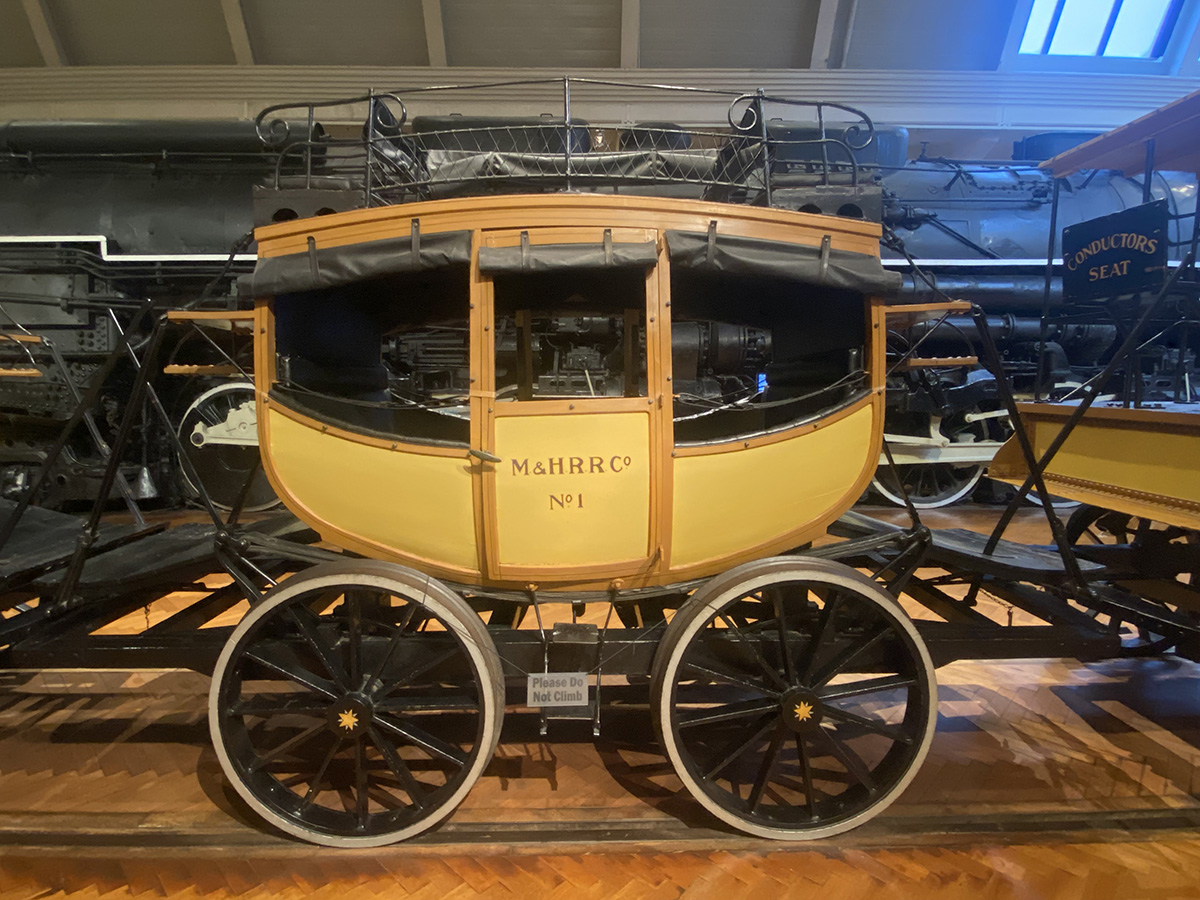
First car
Made in 1893 by the New York Central Railroad for the World’s Columbian Exhibition in Chicago and various promotional events, the locomotive and passenger cars are replicas of the 1831 DeWitt Clinton. Henry Ford acquired the replica locomotive and carriages in the 1930s, which are now displayed on railroad tracks as if ready for their next journey.
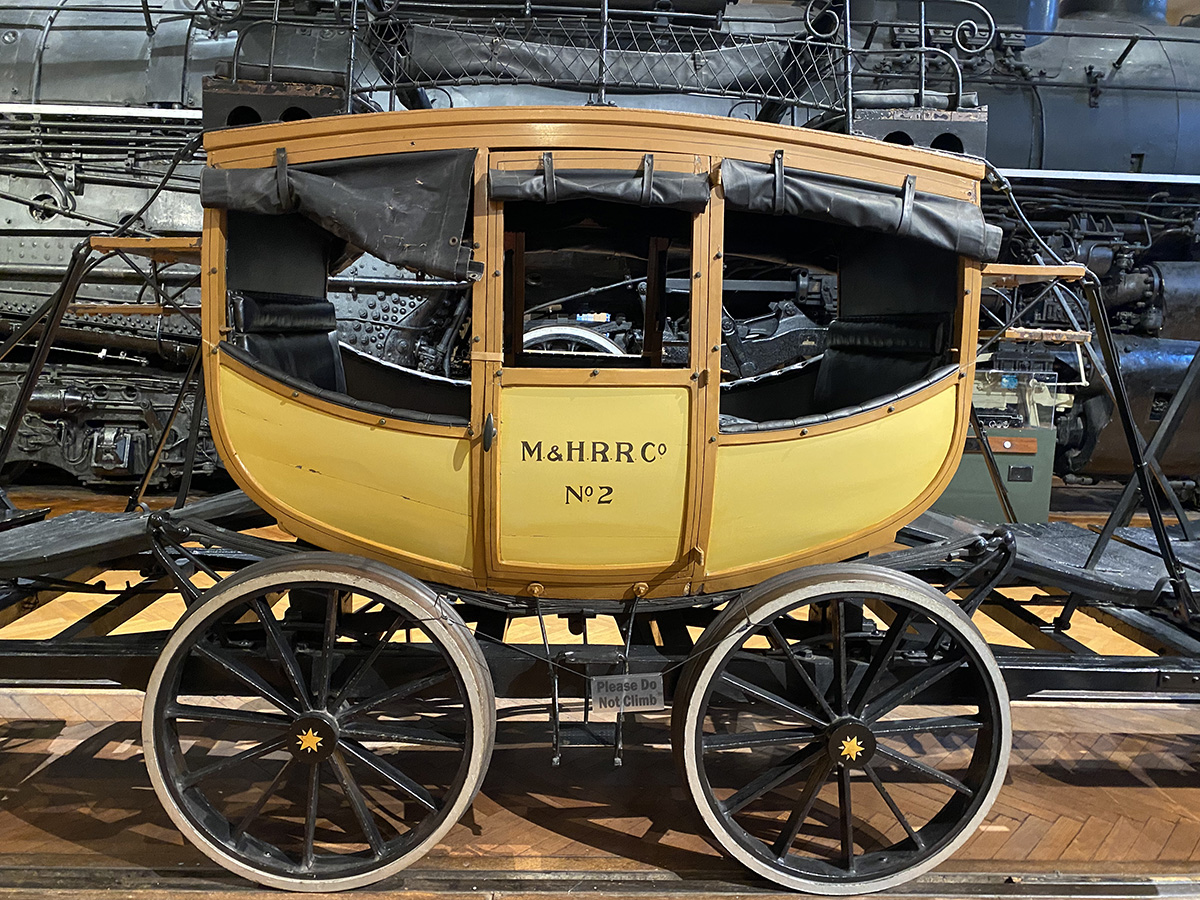
Second car
Both their days of use and time on display have contributed to the wear and tear on the locomotive and its cars. Our fabulous clean team documents changes to the artifacts to report to Conservation. For the replica DeWitt Clinton passenger cars, the clean team noticed broken leather straps, lost paint, torn leather cushions, and a missing seat cushion.
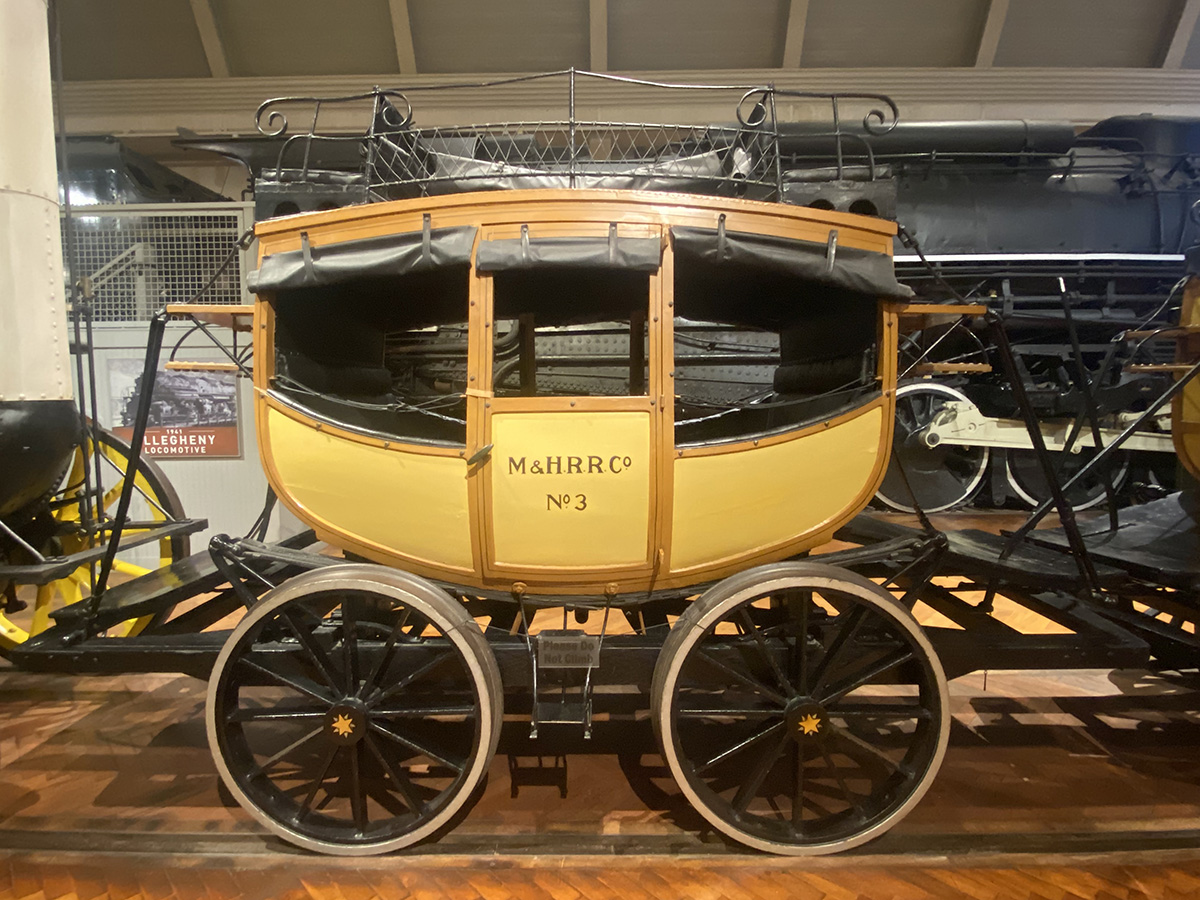
Third car
This year, we made it a priority to give the cars conservation attention. Since these are large artifacts, instead of moving them to the conservation lab, cleaning and repairs were done on the museum floor.
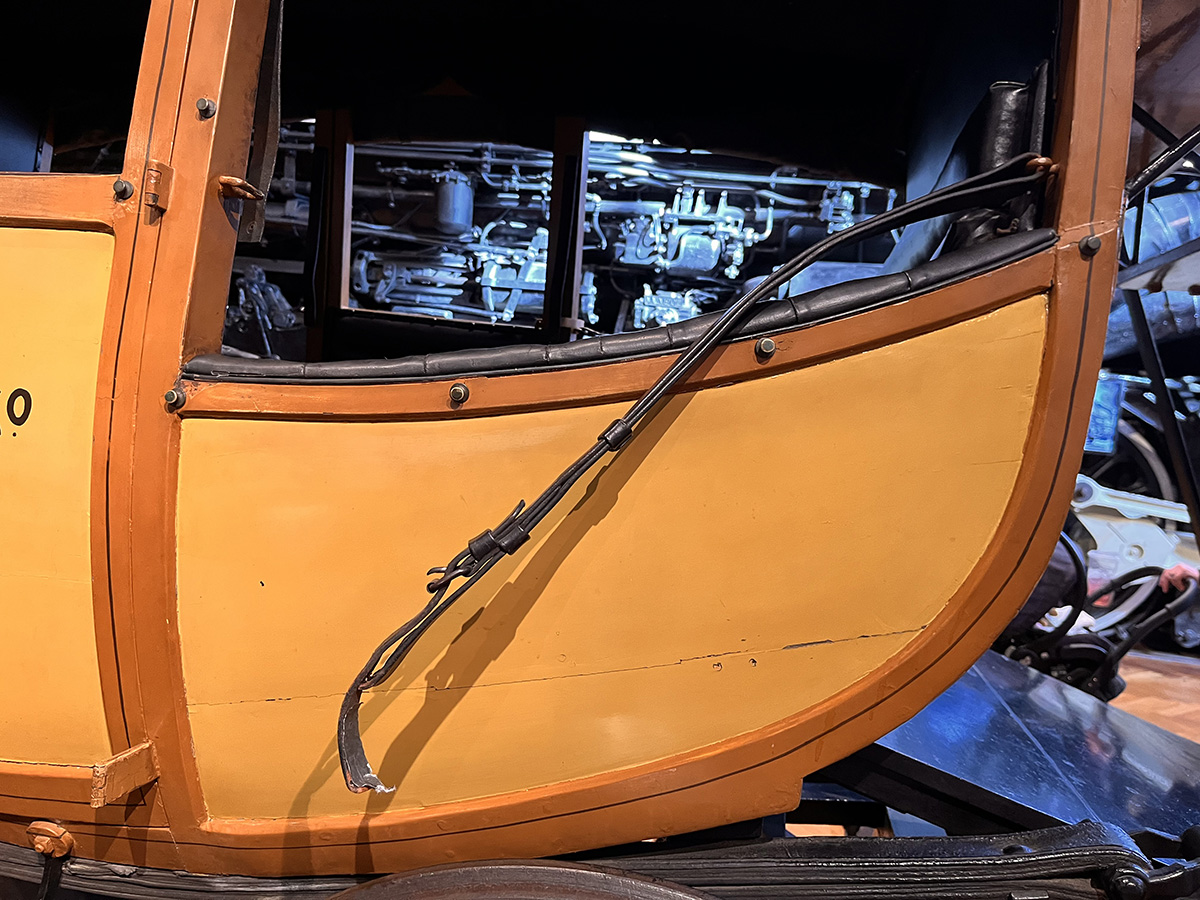
Broken leather strap on one of the cars
First, broken and brittle leather belt straps in the windows of each car were removed for replication by a local leather worker. The straps were measured and fabricated to match the full length and appearance of the original straps in completed form. The original metal buckles were saved to fit the straps back to the windows.
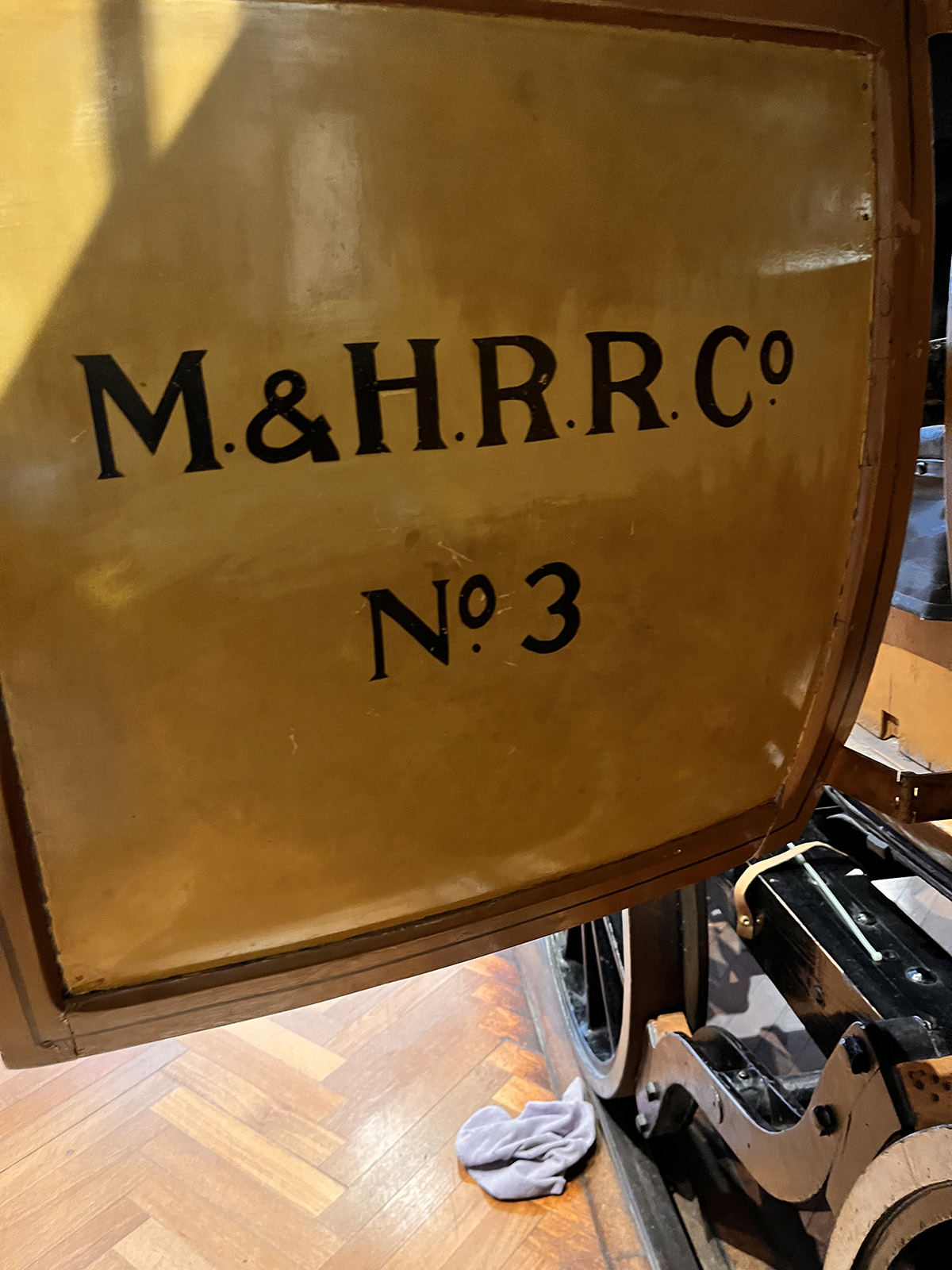
Surface grime on car exteriors visible around the lettering
The exteriors of the cars were cleaned to remove surface grime and expose the richness of the bright mustard and reddish-brown paints. At this stage, it allows us to see other issues that we may have missed upon the first examination. Not only were paint losses visible on the surface, but losses in the wood frame were found on the rear car.
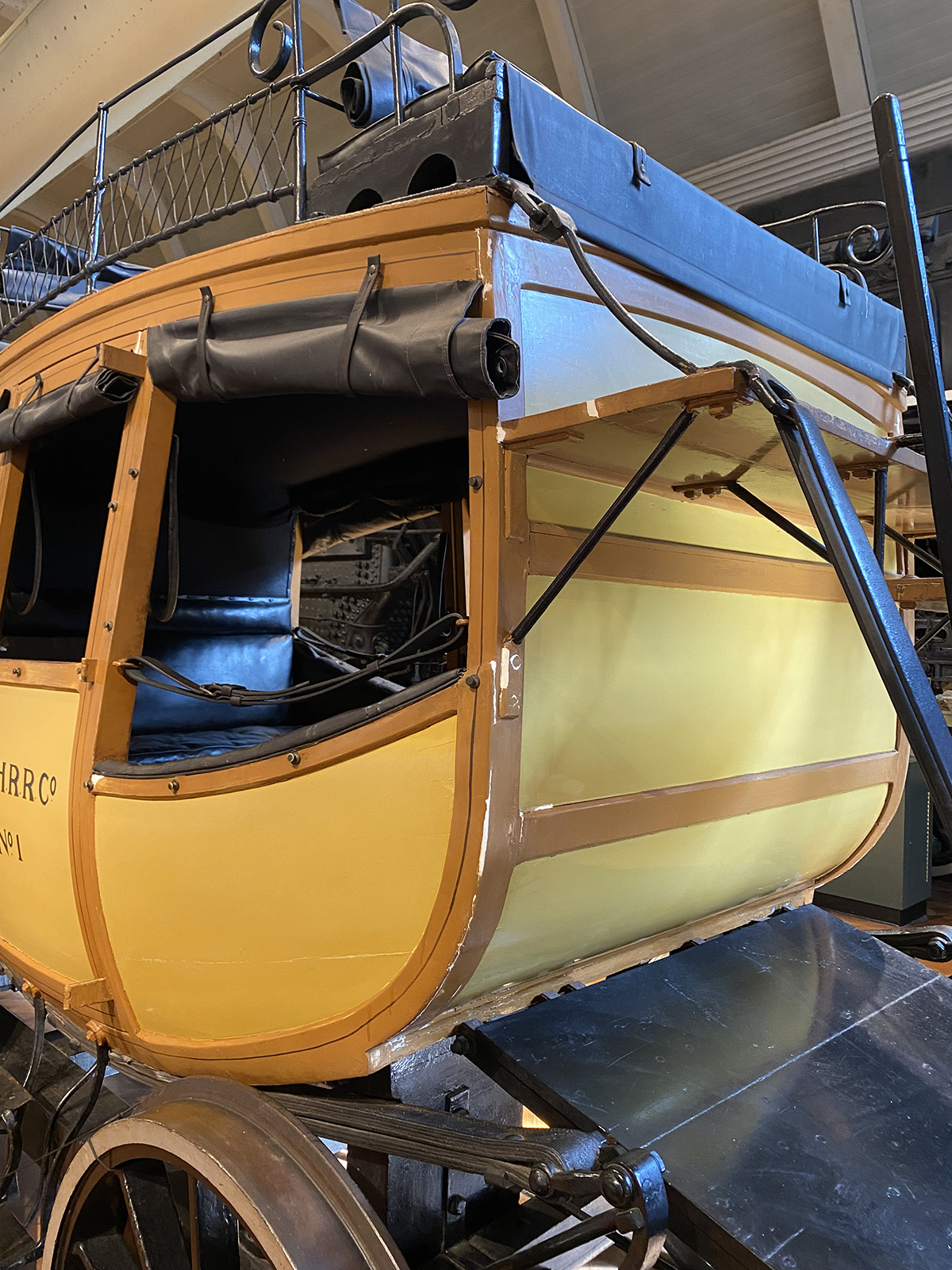
Filled losses with gesso to create even layer before painting
The unstable paint was carefully adhered back in place and large losses filled with gesso or wood putty before painting to match the rest of the car.
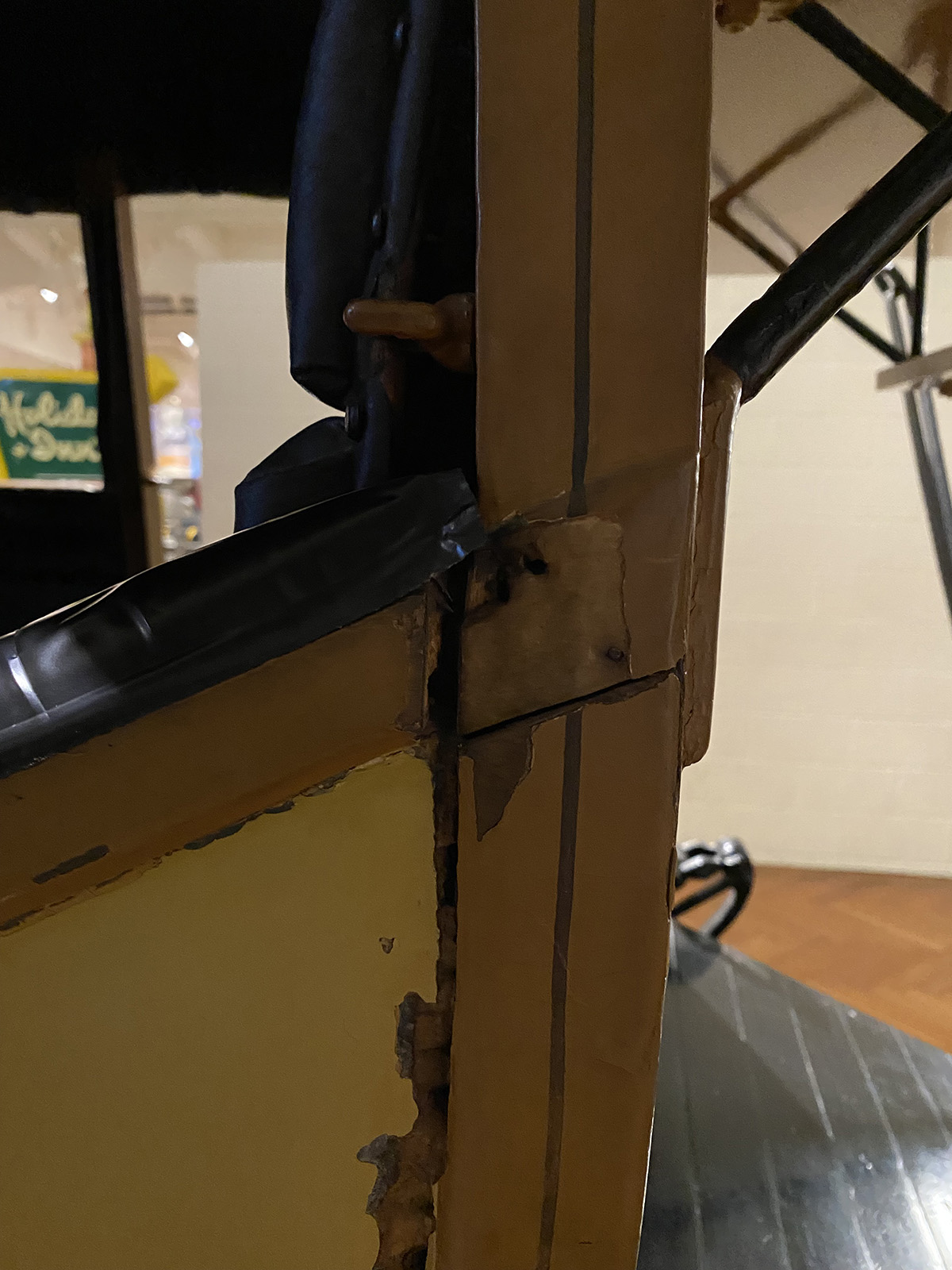
Wood putty fill in center
Pinstripes and lettering on the car doors were also touched up. If there was structural damage, strong wood putty was used, otherwise the gesso was used for shallow fills.
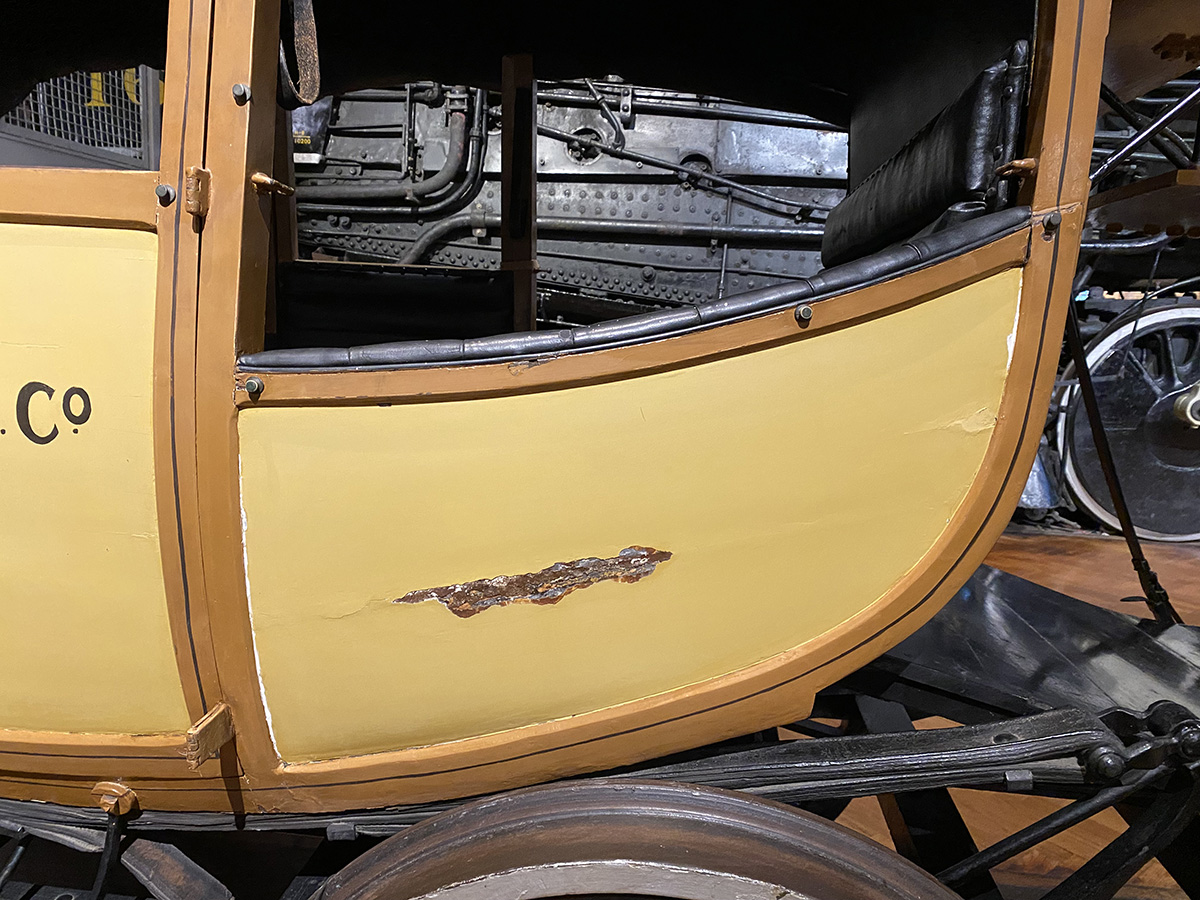
Large paint loss on side panel
Otherwise, after concocting just the right proportions of pigments, wax fills were chosen to provide good color match for shallow surface damages. Smaller losses were filled with the pigmented waxes applied vertically using a warm tacking iron, mindful not to drip wax everywhere!
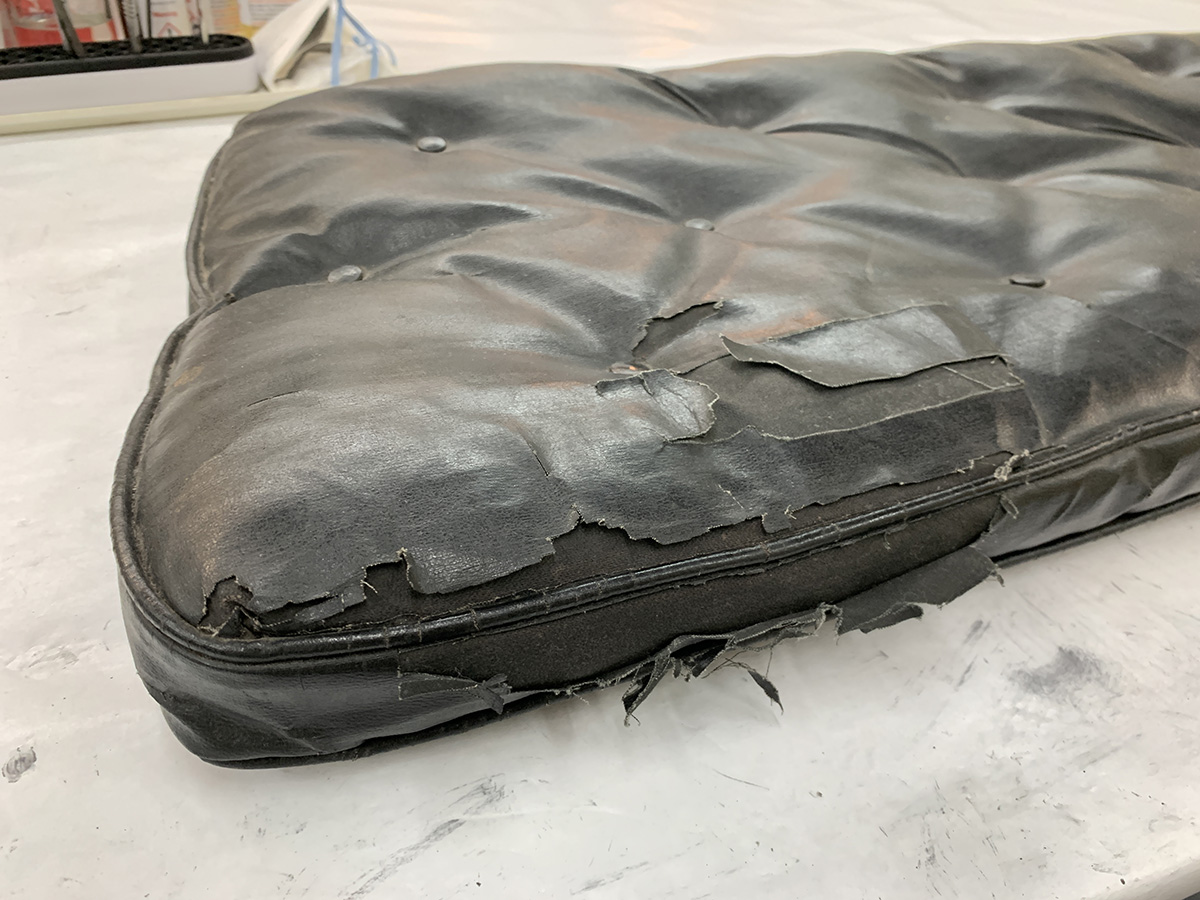
Torn leather on cushion
Tufted seat cushions with torn leather were removed from the cars and taken to the conservation lab. The tears were mended with adhesive film activated by heat. Any gaps in the lost leather were filled with pigmented wax. The buttons were re-secured where necessary with stronger twine.
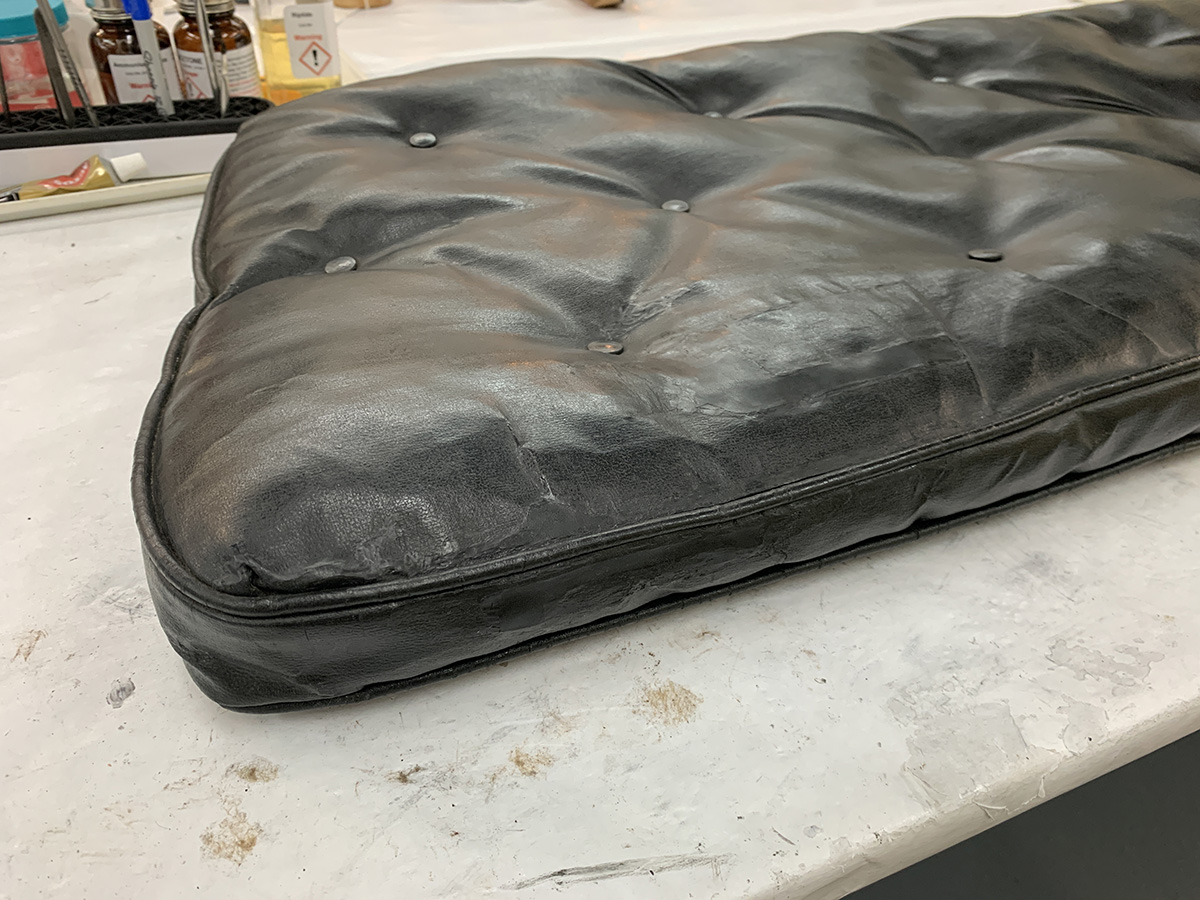
Cushion after stabilization
The missing seat cushion on one of the cars was recreated by a local car upholsterer. See if you can spot the new one! We make sure new materials added to artifacts are documented in condition and treatment reports for future conservators to know what is original versus a replication.
Each car's leather armrests had been previously repaired with tape strips to cover lost material or insecure leather. Over time the tape started to peel away, drawing more attention to these damaged areas.
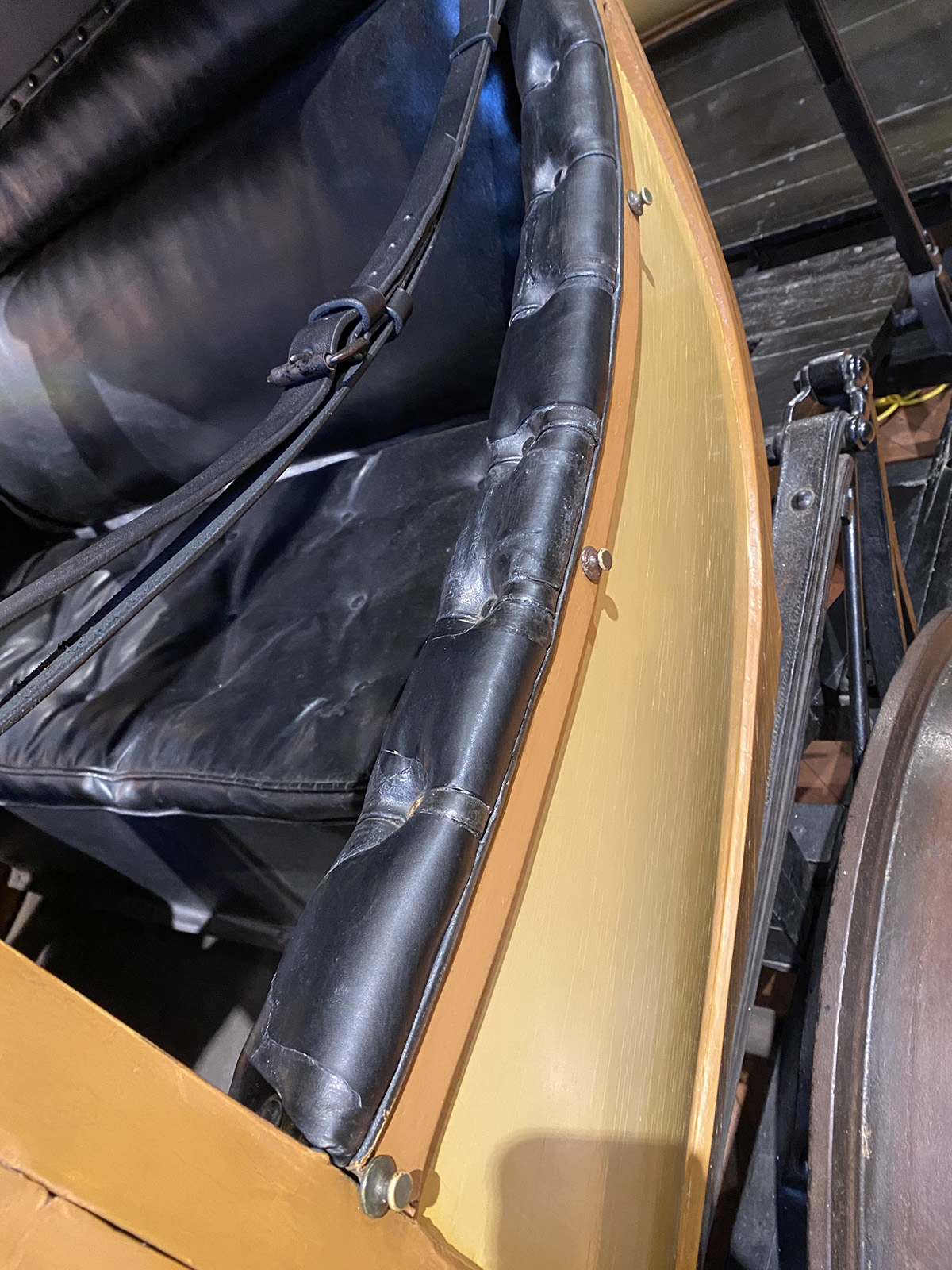
Adding leather tape patches to losses on armrests
We removed the old tape and adhesive before attaching leather tape patches cut for specific loss areas instead of covering the entire armrest.
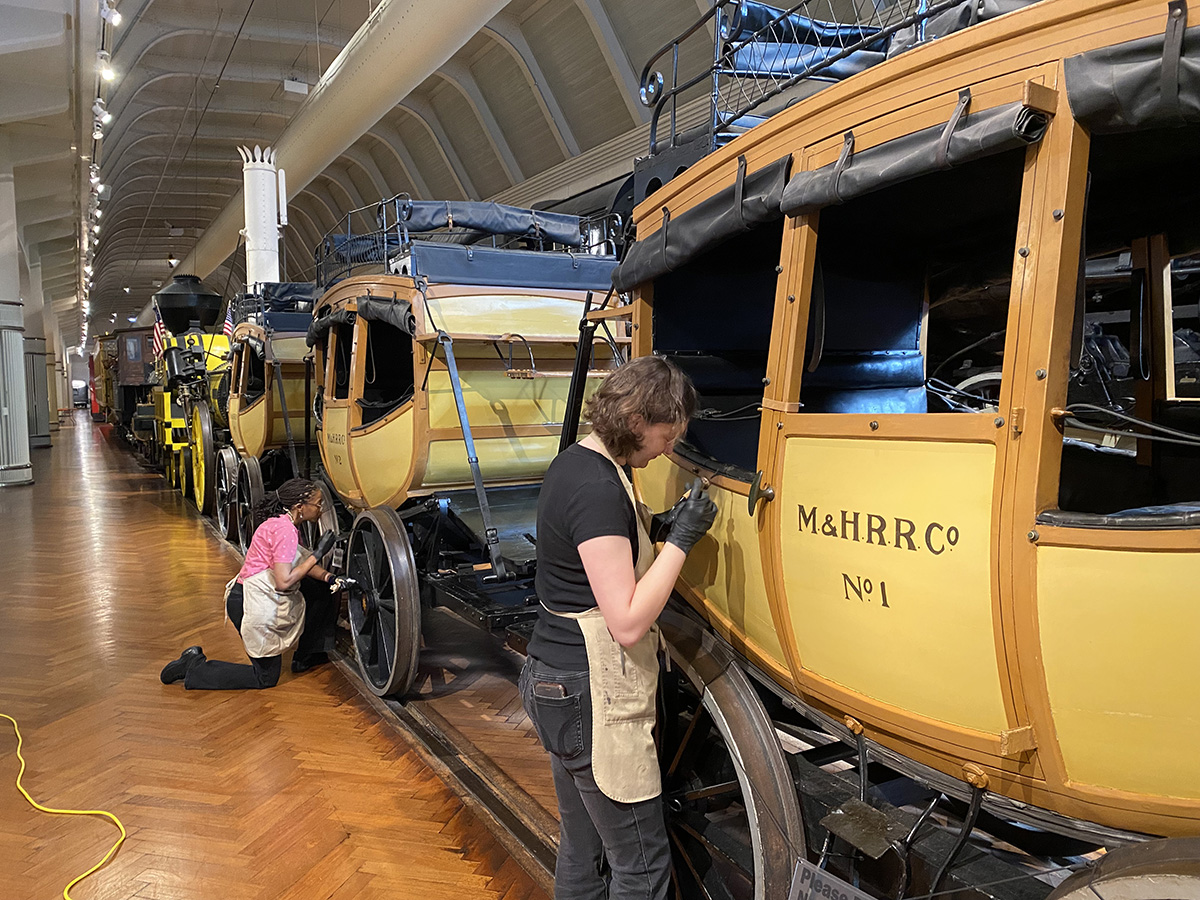
Applying wax to small losses on armrests
As seen with the seat cushions, pigmented wax was applied to the gaps between the original leather and the new patches to create as seamless a finish as possible while securing the edges of the tape to the armrests.
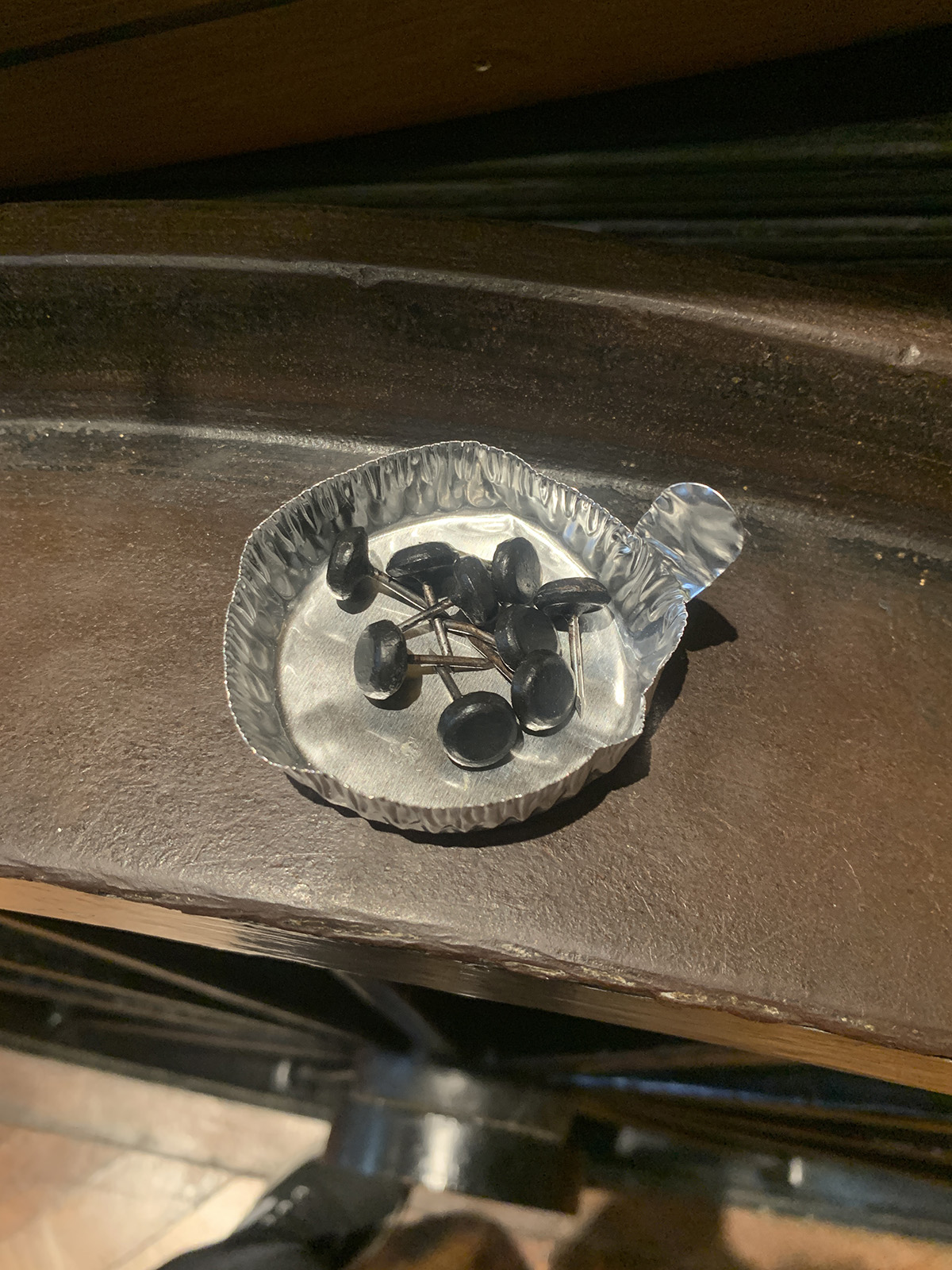
3D-printed tacks ready for attachment
Final additions involved replicating lost tacks around the window shades and interior leather panels of each car. Example tacks were scanned to create digital models for 3D printing. Close to 100 printed tack models were then painted to look like corroded metal or leather covers for the tack heads and secured with adhesive. Once the last tack was attached, our rejuvenating treatment was complete!
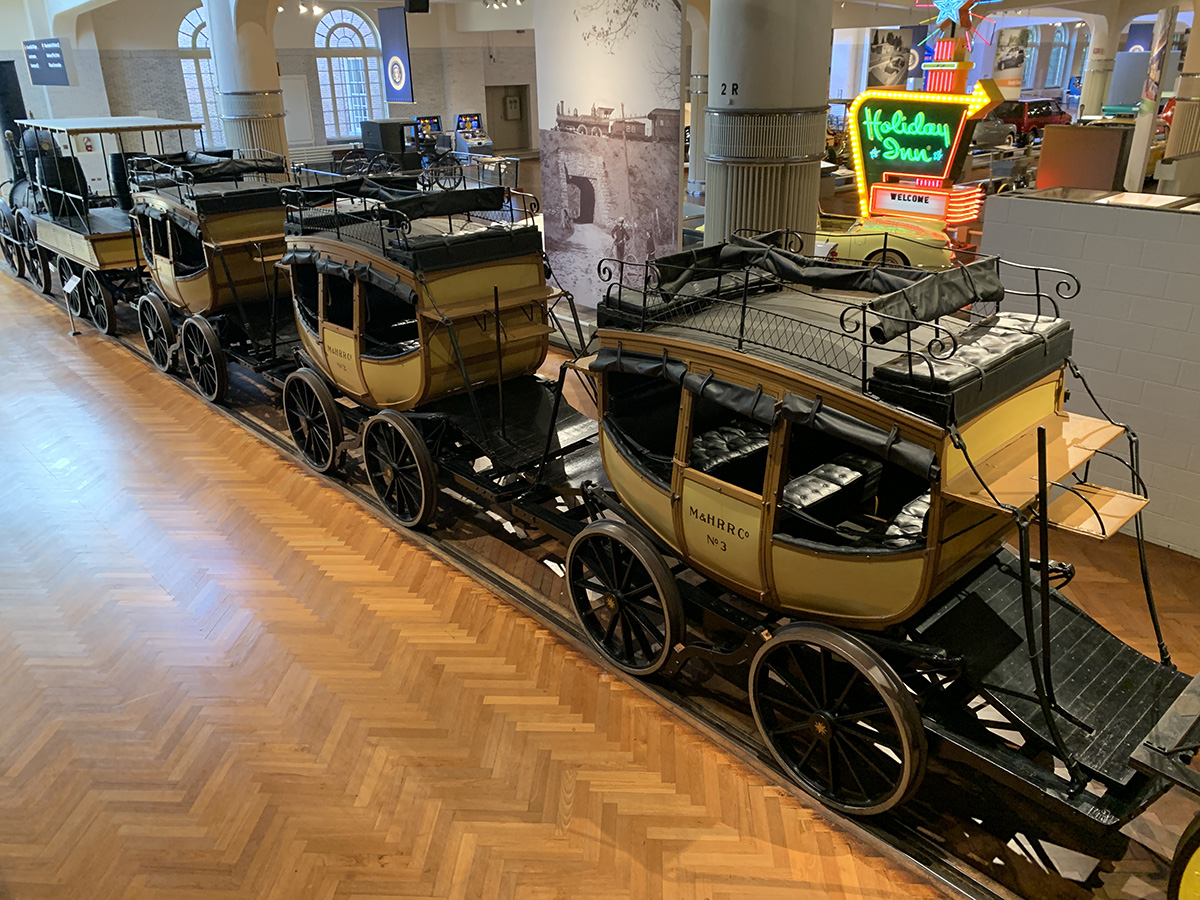
View of all three cars from the Allegheny
We heard many visitors standing in awe of the replica DeWitt Clinton and what must have been quite the experience of riding these passenger cars long ago. This behind-the-scenes look at what it takes to preserve some of the larger items in our collection gives a taste of the detailed work our conservation team does every day to continue the legacy of these historical artifacts.
Marlene Gray is a senior conservator at The Henry Ford. Huge thanks to conservation specialists Fatima Sow, Julia Fahling, Scott Powers, and senior conservator Cuong Ngyuen for their work on the passenger cars.
Conserving the Desk That Helped Tell Ulysses S. Grant’s Story

Background shows a sneak peek of the conservation treatment of Gen. Ulysses S. Grant’s desk. / Image of Grant writing his memoirs in July 1885 courtesy of the Library of Congress.
The Henry Ford has quite a collection of objects used by historical figures on display. There are many more gems safeguarded in storage with equally fascinating stories. One such piece is Army General and 18th U.S. President Ulysses S. Grant’s secretary desk. Henry Ford was interested in collecting items tied to people he admired. That is why he purchased Grant’s desk from renowned antique dealer Israel Sack of Boston, Massachusetts, in 1930. The desk had passed down through the family of Grant’s wife, Julia, before making its way to the former president. Grant used this desk while writing his “Personal Memoirs” in 1884 and 1885. Recently, the desk has made its way to the museum’s conservation lab for a bit of TLC and a taste of the limelight.
Continue ReadingThe Hidden Painting of Robert Frost Home

Unknown artist, “Lady in a Lace Bonnet,” located in Robert Frost Home in Greenfield Village, before conservation. / Photo by Marlene Gray

The same painting, after conservation. / Photo by Marlene Gray
It is that time again, as Greenfield Village opens this week for another exciting season! While you were away, staff at The Henry Ford have been busily cleaning and repairing objects throughout the village buildings. During the winter months, conservation staff move artifacts in need of repair back to our labs for a bit of TLC. Some of these objects are on full display while others hardly ever get the spotlight. One of the latter objects is a painting rarely seen by visitors.
View of Robert Frost Home with the parlor on the right. / THF1883
Within the Porches and Parlors district of Greenfield Village is the home of American poet Robert Frost. Originally located in Ann Arbor, Michigan, the house was moved to the village by Henry Ford in the 1930s. As you enter the house, a parlor is on the immediate right. If you look inside on the left, you will see a frame on the wall. There hangs a portrait of a woman, “Lady in a Lace Bonnet.” During routine maintenance, our dedicated clean team noticed the painting had some paint losses, which you typically find with old paintings. The paint losses at the top and bottom of the painting were the most obvious. These types of losses can occur when the painting is roughly handled during framing.
Image courtesy of clean team member Teresa McCloud, who noted the damage.
Conservation staff then brought the artwork to the lab to give this hidden painting some much needed attention. Once the painting was removed from the frame, the next step was a good cleaning. Paintings trap abrasive dust and debris, both on the canvas behind and the painted surface. After vacuuming to remove the larger debris, a very mild cleaning agent was used to remove the surface grime collected over the years. What a drastic change that made!
Grime cleaning, with right side cleaned. / Photo by Marlene Gray
Still, the portrait had a yellow tint, visible in the sitter’s face, which is a tell-tale sign of an aged varnish. Various solvents were tested to see what worked best at removing the old varnish, and we selected one that did not cause harm to the paint surface. After the varnish was removed, the portrait looked much brighter and fresher.
Varnish removal, with left side cleaned. / Photo by Marlene Gray
Once our lady was cleaned, it was time to tackle the paint losses. Color-matching the surrounding paint is tricky and takes patience to get right, but when we do, it is so rewarding to see the complete image. Last but certainly not least, a new coat of varnish with stabilizers that resist the harmful effects of ultraviolet radiation was added to protect the painting from light from the window on the other side of the parlor.
After securing the painting back inside the frame (being sure not to scratch the surface), we whisked it back to Frost home, tucked into its “hidden” spot. Now you know what hangs on the wall, and you may even be able to get a little peek from outside the parlor window on your next visit. The lady will be happy to show off her fresh appearance!
“Lady in a Lace Bonnet” returned home. / Photo by Marlene Gray
Marlene Gray is Senior Conservator at The Henry Ford.
collections care, conservation, Greenfield Village buildings, Greenfield Village, #Behind The Scenes @ The Henry Ford, by Marlene Gray, art, paintings
The Crafty Sport of Paper Wigs

For a museum professional who takes care of collection objects, it isn’t often that the opportunity to be crafty comes along. When it does, however, those random skills you never thought would be useful come in handy.
Case in point was a mannequin for our latest What We Wore display, featuring clothing and accessories related to sports, that needed a fresh hairstyle. Paper wigs are useful in creating a simple look, but can also give a “wow” factor that regular wigs cannot. For our cycling mannequin, we attempted the windswept, curly style of the early 20th century. What follows is the process it took to make this paper wig. May it inspire you to try crafting your own!
The useful tips and tricks detailed by the FIDM Museum & Galleries and the Museum of Applied Arts & Sciences were invaluable resources to start the process. First, the search for suitable paper was a challenge, based on the recommendation of a 70 lb. watercolor paper. The art store had a wide selection of papers, but nothing that fit that description perfectly. We tried two samples: a 74 lb. smooth, waterproof synthetic paper made of polypropylene, and a textured 90 lb. cotton fiber watercolor paper. Both had their strengths and weaknesses, based on dyeability, strength, and size. Trial and error with curling the papers determined that the cotton fiber paper was best for this project because it was a bit more durable and gave us the option for coloring the paper.
Comparison of the synthetic paper on top and the cotton fiber watercolor paper on bottom.
The next step was deciding how to cut the paper into strips. We tried straight, long “hairs,” and a half-rainbow segment, but ultimately went with a wavy rainbow that created the perfect curly appearance.
Leave a ½-inch edge at the top of the hair sections, as this will be the “roots” that attach to the mannequin head.
As for curling the strands, here is where those random skills help! The suggestion was to wrap the paper strands around a #2 pencil or the end of a paintbrush to create the waves. However, we found that pulling the paper with scissors, a technique used for curling balloon ribbons, was most effective in getting the result we wanted.
We then took our fabric-covered foam head and decided where the hairline should start and in which direction to start attaching the strand sections. We used straight pins to keep the “hair” in place, but you could also use double-sided tape or glue, depending on the material of the mannequin head and its intended use afterwards. For us, since the hair is pinned in place, it is easily removable for the next exhibit.
A hat would be placed on top, so we pulled the sections of hair back around a ball of tissue paper for volume and extra support. These sections were taped, because the pins would slide out from such a thick amount of paper to secure. A circular piece of foam was placed on top of the head so that the hat could be secured in place with long pins
Ball of tissue inside the first layers of “hair.”
Attaching the final strands to the head.
The great thing about paper wigs is that you are limited only by your own creativity! Ribbons, feathers, and hairpins can all be added to create even more style. Depending on the paper used, colorful looks are also an option.
And voila! Here we have our cycling fashionista enjoying some time with her other athletic friends. Be sure to come to the museum and see our new What We Wore exhibit, featuring sports, on display all summer.
The cyclist, with her paper wig, in the What We Wore sports display, currently on exhibit in Henry Ford Museum of American Innovation.
Marlene Gray is Senior Conservator at The Henry Ford.
by Marlene Gray, #Behind The Scenes @ The Henry Ford, making, fashion, What We Wore, Henry Ford Museum, collections care
Staff Favorites from the IMLS Grant
Now that we are getting close to wrapping up our Institute of Museum and Library Services (IMLS) Museums for America grant to conserve, photograph, catalog, and rehouse artifacts from our collection, some of the staff who have worked on this grant would like to share interesting objects they’ve encountered over the course of the grant.
Marlene Gray, IMLS Project Conservator, has three objects she would like to share.
Dodge & Zuill Easy Model C Washing Machine, circa 1912 / THF186088
As the IMLS Project Conservator for the last year of the grant, clearing space for larger objects in storage was our main priority. However, there were chances to conserve some interesting objects, one of which was a copper electric washing machine from the early 20th century. The dazzling copper tub was a sight to behold while in the conservation lab. While cleaning it, I remember thinking how grateful I am that technology has come such a long way in making tasks simpler!
Next is this footwarmer from the mid-19th century:
Footwarmer, 1830-1860 / THF185807
This footwarmer was a cute object to conserve because of the decorative elements in the wood frame and pierced tin stove box. One of the wooden columns had separated from the rest of the object. The opportunity to completely reassemble the object and give it a thorough cleaning made it feel as though the little stove could still be heated for the approaching cold months.
And finally, this lubricator cup assembly:
Lubricator Cup Assembly / THF181364
The great thing about conservation is that you are always learning about history through ordinary objects. While the conservation treatment of this object involved relatively simple metal polishing and glass repair, learning about the inventor of the lubricator cup, Elijah McCoy, and his connection to Detroit was fascinating. I highly recommend exploring his story, like I did!
For more information about the conservation process, as well as other milestones that we reached during this grant funded project check out Behind the Scenes with IMLS: Cleaning Objects, Behind the Scenes with IMLS: “Extra Large” Objects, and Exposing the Collections Storage Building.
Next up are Susan Bartholomew and me, Laura Myles, Collections Specialists in the Registrars’ Office. We have worked closely cataloging and researching the objects that have been selected for the grant. It was hard to narrow down our favorite objects, or at least the ones we think are the most interesting, but here is a brief overview of some of the objects we enjoyed working with the most.
My name is Susan Bartholomew. I am a Collections Documentation Specialist and simply put, my role in this project was to update or revise catalog records for objects selected for the grant. This included identifying and applying accession numbers, which allow us to track an object both physically and digitally using our database, as well as conducting provenance research, and creating or modifying existing records in our database using cataloguing standards.
My personal highlights for this grant include the following.
Model of a Hook and Ladder Truck, circa 1900 / THF170406
This incredibly detailed handmade model of a turn-of-the-century fire truck is complete with removable ladders, firemen’s tools, and what are possibly the world’s tiniest leather fire buckets.
Shop Sign, 1870-1920 / THF175572
From the tiny to the huge, this is a shop sign in the form of a giant gold-painted tin teapot. It stands over three feet tall and four feet long from spout tip to handle. For more information about this unique giant teapot, check out this blog post Senior Conservator Louise Beck wrote about its surprising discovery.
Acoustic Telephone, circa 1878 / THF176648
A very early example of a type of telephone that had no batteries, this device operated on the same principle as two tin cans connected by a string, an idea that had been around for centuries. They were used in pairs and were connected over a short distance by a tightly stretched wire. With no dependence on electricity, they were advertised as being more reliable than battery-operated telephones. This unit was one of a pair used by the father of the donor to connect the flour mill he operated to the boats he used to ship his flour. One set would be at the mill and the other was placed on the wharf boat half a mile away.
And now, Laura Myles shares her favorites.
Like Susan, I have assisted with cataloging, but I also research objects more in depth to uncover missing dates and/or manufacturers, as well as approving records to go online into our Digital Collections. Working on the grant over the last three years has been a wonderful learning experience, as the objects are so varied you really have no idea what to expect.
Charles Ponti Megalethoscope, 1862 / THF179318
Charles Ponti Megalethoscope, 1862 / THF179324
Megalethoscope Slide, "St. Mark's Square," unlit / THF179345
Megalethoscope Slide, "St. Mark's Square," lit up / THF179346
Perhaps my most favorite object is the megalethoscope and its slides. One of the best parts of my job is rediscovering hidden treasures in the collection. While we knew this was something special by looking at it, it was not until we were working on the slides that we knew how truly special it was.
At first glance, it looks like the megalethoscope is a fancy magic lantern device—merely projecting the images on slides. The megalethoscope was designed by Charles Ponti while he was living in Venice, Italy circa 1862. Ponti photographed his travels through France, Switzerland, Italy, and Egypt, and it was these photographs that he turned into transparencies for his megalethoscope, costing five francs each at the time. These transparencies look like normal slides until they are inserted into the megalethoscope and manipulated to show night views painted onto the backs of the images but hidden by a dustcover. One of the 22 slides can be seen above. For even more information about the megalethoscope, here is a blog post written about its conservation and photography.
Naval Cannon, circa 1780 / THF179510
Another object that I enjoyed researching was this naval cannon. While we know this cannon was accessioned in 1929, we do not have information about who made it or where it was used. Based on its estimated manufacture date, circa 1780, and similar design to British artillery, I reached out to the Royal Armouries, which helped eliminate the possibility of it being British in origin. Unfortunately, we do not know its history, but at least we know it was very likely made in the United States to be used on a merchant marine vessel.
Sign / THF172438
This sign advertising the O. H. Perry Inne is one of my favorites just for its connection to the War of 1812 and Oliver Hazard Perry. On the front of the sign is a portrait of Perry, there is an eagle with seventeen stars above (although there were eighteen states by 1813, further adding to the mystery), and the words “Lake Erie” below on the reverse. Perry was regarded as a hero after defeating a British squadron in Lake Erie, which led to Detroit being freed from British control. Unfortunately, this sign’s history has been lost to time, although there are similar signs that have come up for auction. It seems likely that some local establishment capitalized on Perry’s name, probably along Lake Erie. We can only imagine the building it adorned.
Spittoon / THF186256
One of the more recent objects to make my short list, and Susan’s as well, is this turtle spittoon. We think it is one of the cutest objects to have come through the IMLS pipeline, especially since spittoons themselves are not the most elegant of objects. Apparently turtle designs for spittoons were quite popular in their time, as well as remaining popular among collectors. The one in our collection is functional: pressing the turtle’s head flips open the shell to reveal the bowl.
If you would like to know more about the cataloging process, you can read more about that here (and see a few more interesting objects we have worked on as a result of this and a previous IMLS grant), and if you would like to know more about the provenance research Susan refers to, check out Associate Registrar Aimee Burpee’s blog post.
This is but a small sampling of some of our favorite objects from this grant. Over the course of the grant so far, we've digitized nearly 3,000 objects, and cataloged and conserved over 4,300 total objects. Unfortunately, this means that we had to be a little bit picky in what we shared here, but hopefully you will discover more of the treasures from our Collections Storage Building yourself while searching our Digital Collections.
Marlene Gray is IMLS Project Conservator, Susan Bartholomew is Collections Documentation Specialist, and Laura Myles is Collections Specialist, all at The Henry Ford.
by Marlene Gray, by Susan Bartholomew, by Laura Myles, digitization, research, conservation, collections care, #Behind The Scenes @ The Henry Ford, IMLS grant
When Conservation Met Digitization
For the entire month of November, we at The Henry Ford are celebrating the digitization of over 100,000 artifacts! To reach a goal of 100K artifacts digitized takes many people and departments coordinating and working together. Let’s look at how our conservation department contributed to this momentous achievement. I’ll be highlighting one of the current projects in which digitization is a crucial step.
This graphic shows the various steps in The Henry Ford's digitization process, and where conservation fits in.
As Project Conservator on a three-year Institute of Museum and Library Services (IMLS) grant awarded to The Henry Ford, I work with other conservation and collections specialists to clean and stabilize 3D objects from our Collections Storage Building. These objects oftentimes have never been on display, let alone photographed. As conservators, it’s our responsibility to make sure the objects are not only camera-ready but are structurally sound for exhibition or museum storage.
For this IMLS grant, the objects undergo a multi-step process involving many hands in order to get to digitization. First, objects are tagged by collections or conservation staff with a Tyvek label that states the object number (if known), description/identifying name, and location found in storage. This tag stays with the object throughout the various stages and is updated with staff initials as tasks are completed.
Objects are then vacuumed to remove surface dirt and/or mold before moving from the storage building to be cleaned thoroughly in the Conservation Lab. If the object is too large to handle, it stays in the building for conservation treatment performed in a section that has been zoned off as a clean room. Outside contractors bring in heavy-duty equipment to lift and move the bigger and heavier objects.
A Herschell-Spellman steam engine (27.139.1) rigged up for moving out of storage.
Caravan of large objects being moved out of storage!
If the object is an appropriate size for the IMLS team to handle and move by forklift or box truck, we bring it back to the Conservation Lab for cleaning and stabilization.
Due to the number of objects we conserve, not all get photographed in the lab. That will happen later! However, we do take before, during, and after conservation treatment photos for some objects that have interesting conservation treatments and/or a significant change from start to finish.
Check out a recent blog on the conservation treatment of this Megalethoscope (32.742.113).
Other staff are also involved in the IMLS grant, including registrars who catalog and attach a unique accession number to each object.
Quick photographs are often taken at this stage in order to research and find more information about the object.
Finally, the object is ready for its close-up! It moves down to our photography studio to be photographed under the proper lighting and with a professional grey backdrop. Sometimes the object is so large that is easier to photograph it in its new storage location. You can find all of these images in our Digital Collections on THF.org.
Here is a Pratt & Whitney Gear Cutter and Lathe, circa 1900, getting set up for photography in storage.
Click here to visit our Digital Collections and search for digitized artifacts!
As we are all facing challenges this year brought on by the COVID-19 pandemic, we have had to adopt new procedures to keep the process running smoothly! It has not been possible to photograph all objects included in the grant. Before the object leaves the conservation lab and moves to storage, though, it gets quickly photographed, and that image is attached to the record in our collections database.
At a later date, our photographer will take the beauty shot for Digital Collections and keep the tally rolling on our digitization numbers! As of today, over 3,500 objects have been pulled from storage, conserved, and rehoused during this three-year grant. Close to 3,000 of those objects have been digitized and are available online.
Photographer Rudy Ruzicska taking the perfect image.
The final step for these objects is moving to a new home in storage, going on loan, or display for THF visitors to see up close. We work with collections management staff to box, palletize, and wrap the objects before finding the perfect location in storage or sending them on their next adventure for public viewing. The objects from this IMLS grant are just a small portion of the 100,000 artifacts that have been digitized, but they also include some of the largest objects we have in the collection!
A couple of generators sitting in front of boxed and palletized objects in storage.
Let’s end with a blast from the past of The Henry Ford’s early digitization days in 2012. Here are a few images of what it took to digitize an abundance of hubcaps! Some of these you may have seen on display in the Driving America exhibit. The rest you can find in Digital Collections.
For an in depth look at hubcaps, check out this blog post.
Congratulations to all who have helped over the years to get so many of The Henry Ford’s artifacts digitized and accessible!
IMLS grant, #digitization100K, #Behind The Scenes @ The Henry Ford, by Marlene Gray, collections care, conservation, digitization
Exposing the Collections Storage Building
This blog post is part of an ongoing series about storage relocation and improvements that we are able to undertake thanks to a grant from the Institute of Museum and Library Services (IMLS).
A typical aisle in the Collections Storage Building before object removal.
Autumn of this year marks the end of a three-year IMLS-funded grant project to conserve, house, relocate and create a fully digital catalogue record for over 2,500 objects from The Henry Ford’s industrial collections storage building. This is the third grant THF has received from IMLS to work on this project. As part of this IMLS blog series, we have shown some of the treatments, digitization processes and discoveries of interest over the course of the project. Now, we’d like to showcase the transformation happening in the Collections Storage Building (CSB).
A view of the aisle and southwest wall before dismantling to create a Clean Room.
Objects were removed from shelves allowing an area in the storage building to be used as a clean space for vacuuming and quickly assessing the condition of these objects before heading to the conservation lab. Since the start of the grant in October 2017, 3,604 objects have been pulled from CSB shelves along with approximately 1,000 electrical artifacts and 1,100 communications objects from the previous two grants. As of mid-March 2020, 3,491 of those objects came from one aisle of the building. As a result, we were finally at a point of taking down the pallet racking in this area.
Pallets of dismantled decking and beams. A bit of cleaning before racking removal.
While it has taken multiple years to move these objects from the shelves, it took only three days to disassemble the racking! Members of the IMLS team first removed the remaining orange decking. On average, there were four levels of decking, separated in three sections per level. Next, we unhinged the short steel beams that attach the decking to the racking. Then was the difficult part of Tetris-style detachment of the long steel beams directly by the wall from the end section of height-extended, green pallet racking. As you can see this pallet racking almost touches the ceiling! After that, the long beams could be completely removed before taking down the next bay. Nine bays were disassembled this time to reveal the concrete wall and ample floor space. Just as the objects needed cleaning to remove years of dust and dirt, so did the floor!
The aisle in 2018. An open wall and floor!
What’s next? We will methodically continue pulling objects and taking down racking until no shelf is left behind! We are grateful to the IMLS for their continued support of this project and will be back for future updates.
Marlene Gray is the project conservator for The Henry Ford's IMLS storage improvement grant.
21st century, 2020s, 2010s, IMLS grant, collections care, by Marlene Gray, #Behind The Scenes @ The Henry Ford

